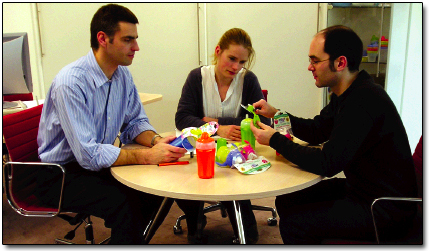3 Designing for users
This section aims to develop your awareness of weaknesses in product designs, from the perspectives of usability and the variability in user populations, and to consider the opportunities for product design for different populations.
Although most producer companies devote major resources to researching the market for their products, many products still appear on the market that seem not to have been designed with their user in mind. You must have experienced or noticed some dangerous, baffling or irritating product design failures yourself. Perhaps sometimes you thought the failure lay with you, in not understanding how to use the product. Maybe you thought the designers just had not made the product sufficiently idiot-proof! But wait – you are not alone. Even professors of psychology get baffled by everyday objects. Here is a short extract from The Design of Everyday Things by Professor Donald Norman.
If I were placed in the cockpit of a modern jet airliner, my inability to perform gracefully and smoothly would neither surprise nor bother me. But I shouldn't have trouble with doors and switches, water faucets [taps] and stoves. ‘Doors?’ I can hear the reader saying, ‘You have trouble opening doors?’ Yes. I push doors that are meant to be pulled, pull doors that should be pushed, and walk into doors that should be slid. Moreover, I see others having the same troubles – unnecessary troubles. There are psychological principles that can be followed to make these things understandable and usable.
Click on 'View document' below if you would like to read more of Professor Donald Norman on 'The Design of Everyday Things'.
View document [Tip: hold Ctrl and click a link to open it in a new tab. (Hide tip)]
Test your understanding
Outline in your own words, in just one or two sentences, the main design principle that Donald Norman illustrates with his examples in the passage above.
Answer
My response
The design principle is visibility, which means making clear how a product operates or is used. Inadequate visibility leads to uncertainty, mistakes and rejection of the product; over-complexity (profusion of controls, and so on) leads to confusion and intimidation.
Why are so many everyday objects not only difficult to use but actually dangerous? Many domestic accidents are associated with using everyday objects such as scissors, knives, can-openers and garden tools and machines. These are perhaps inherently dangerous things that need care in their use, but many accidents also result from perfectly normal use of things such as cookers, heaters and even furniture. Of course, many domestic accidents involve young children, or elderly or infirm people; relatively young, healthy adults are less accident-prone. But surely designers realise that not everyone is a young, healthy adult?

Most designers do recognise that often they are designing products for a wide range of users. It is not fair just to blame designers, when they are working to requirements laid down by producer companies and manufacturers, to quality standards set by retail company buyers, and to cost limits set by prices that consumers are prepared to pay.
Exercise 2 How things don't work
Take a look around your home or work environment. Think about the everyday objects you use as you go about your normal activities. Try to look at them with fresh eyes and become aware of shortcomings that you normally take for granted or products that you might blame yourself for not being able to use properly. Note down any problems you notice and try to think of ways in which they might be improved.
Having recently installed a new electric hob in my kitchen, I found that I was frequently turning the wrong knob for the hotplate I wanted. The layout of hotplates and control knobs is shown in here. Although each knob has an indicator alongside it of which hotplate it controls, it is still easy to make a mistake unless I consciously search through the indicators in order to find the right knob before turning it on.
The following example shows my attempt at this exercise.
Answer
There is no obvious way the four knobs in their present position can relate to the four hotplates, so until I have learned from considerable experience it will be necessary to look and choose consciously every time I want to turn on a hotplate. However, I suggest the control knobs could at least have been grouped in to two pairs, as shown in the animation above, so that the relationships could be more obvious.
